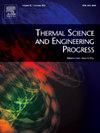Techno-economic optimization of solar adsorption cooling systems for rural health clinics in semi-arid climates
IF 5.1
3区 工程技术
Q2 ENERGY & FUELS
引用次数: 0
Abstract
The increasing demand for cooling can be met sustainably with solar energy, especially with absorption-based systems that combine economic viability with environmental advantages. With an emphasis on system optimization and the effectiveness of similar collectors, this study assesses how well solar absorption cooling technologies function in semi-arid climates. Using mathematical models to simulate energy dynamics and cost parameters, a technical and economic review was carried out. System behavior, including component interactions and convection patterns, was modeled using TRNSYS. Three goals were balanced using a multi-objective PSO (Particle Swarm Optimization) method based on MATLAB: maximizing system profit (SPR), minimizing payback period (PBP), and minimizing primary energy consumption (Qaux). Collector area, storage tank size, inclination angle, solar pump mass flow rate, and cooling fan airflow were important factors.
When compared to flat-plate collectors (FPCs), evacuated tube collectors (ETCs) showed higher operating efficiency, attaining comparable solar ratios while using less energy. In the semi-arid climate, both ETC and FPC perform similarly. However, research indicates that ETCs are generally more effective across various applications compared to FPCs. On average, the collector efficiency is 44 % and 33 %, while the useful energy gain is 445 and 331 kWh/m2 for ETC and FPC, respectively. Obtained results indicated that the average reduction in CO2 emission is 70 kg/m2 for ETCs and 53 kg/m2 for FPCs. Finally, findings from this study revealed that the techno-economic potential of solar thermal systems and solar adsorption cooling systems, including FPC, is the preferred option due to its lower cost in Erbil’s climatic conditions.
半干旱气候条件下农村卫生所太阳能吸附冷却系统的技术经济优化
日益增长的制冷需求可以用太阳能可持续地满足,特别是以吸收为基础的系统,它结合了经济可行性和环境优势。本研究着重于系统优化和类似集热器的有效性,评估了太阳能吸收冷却技术在半干旱气候下的作用。利用数学模型模拟能量动力学和成本参数,进行了技术经济评价。系统行为,包括组件交互和对流模式,使用TRNSYS建模。采用基于MATLAB的多目标粒子群优化(PSO)方法,平衡了系统利润最大化(SPR)、投资回收期最小化(PBP)和一次能耗最小化(Qaux)三个目标。集热器面积、储罐尺寸、倾角、太阳能泵质量流量和冷却风扇气流是影响散热性能的重要因素。与平板集热器(fpc)相比,真空管集热器(ETCs)表现出更高的运行效率,在使用更少的能量的同时获得了相当的太阳能比。在半干旱气候下,ETC和FPC的表现相似。然而,研究表明,与fpc相比,ETCs通常在各种应用中更有效。平均而言,集热器效率为44%和33%,而ETC和FPC的有用能量增益分别为445和331 kWh/m2。所得结果表明,碳排放交易系统的二氧化碳排放量平均减少70 kg/m2, fpc的二氧化碳排放量平均减少53 kg/m2。最后,本研究的结果表明,太阳能热系统和太阳能吸附冷却系统(包括FPC)的技术经济潜力是首选,因为它在埃尔比勒的气候条件下成本较低。
本文章由计算机程序翻译,如有差异,请以英文原文为准。
求助全文
约1分钟内获得全文
求助全文
来源期刊

Thermal Science and Engineering Progress
Chemical Engineering-Fluid Flow and Transfer Processes
CiteScore
7.20
自引率
10.40%
发文量
327
审稿时长
41 days
期刊介绍:
Thermal Science and Engineering Progress (TSEP) publishes original, high-quality research articles that span activities ranging from fundamental scientific research and discussion of the more controversial thermodynamic theories, to developments in thermal engineering that are in many instances examples of the way scientists and engineers are addressing the challenges facing a growing population – smart cities and global warming – maximising thermodynamic efficiencies and minimising all heat losses. It is intended that these will be of current relevance and interest to industry, academia and other practitioners. It is evident that many specialised journals in thermal and, to some extent, in fluid disciplines tend to focus on topics that can be classified as fundamental in nature, or are ‘applied’ and near-market. Thermal Science and Engineering Progress will bridge the gap between these two areas, allowing authors to make an easy choice, should they or a journal editor feel that their papers are ‘out of scope’ when considering other journals. The range of topics covered by Thermal Science and Engineering Progress addresses the rapid rate of development being made in thermal transfer processes as they affect traditional fields, and important growth in the topical research areas of aerospace, thermal biological and medical systems, electronics and nano-technologies, renewable energy systems, food production (including agriculture), and the need to minimise man-made thermal impacts on climate change. Review articles on appropriate topics for TSEP are encouraged, although until TSEP is fully established, these will be limited in number. Before submitting such articles, please contact one of the Editors, or a member of the Editorial Advisory Board with an outline of your proposal and your expertise in the area of your review.
 求助内容:
求助内容: 应助结果提醒方式:
应助结果提醒方式:


